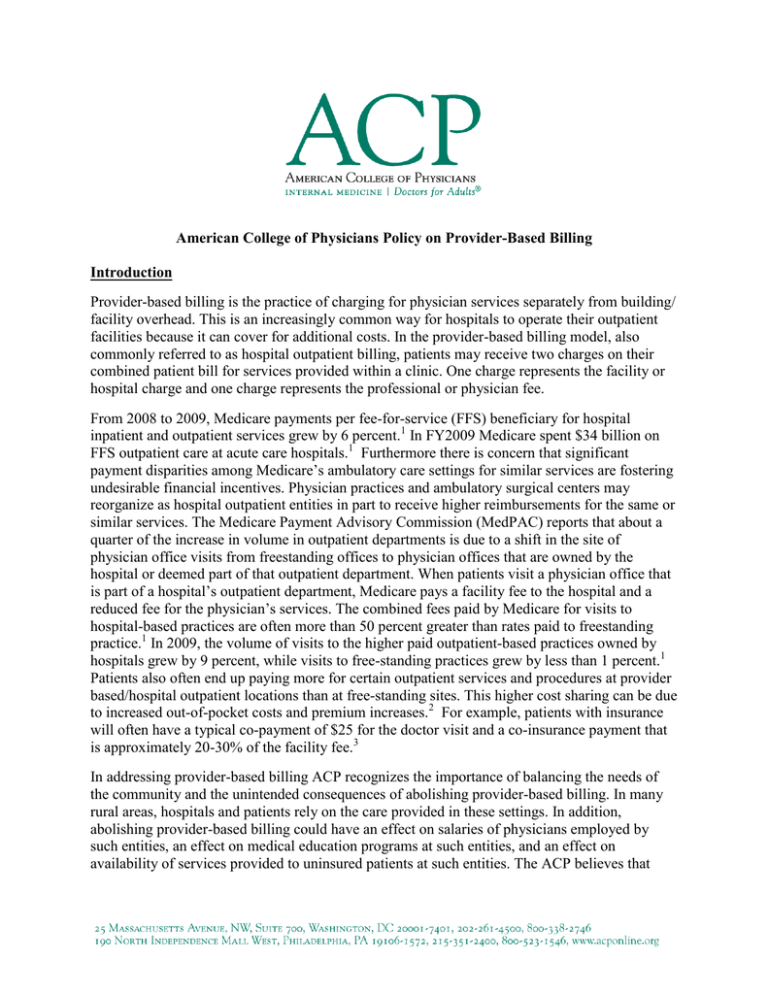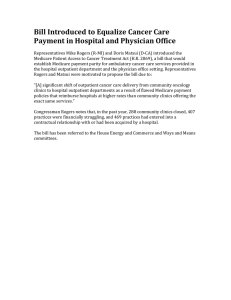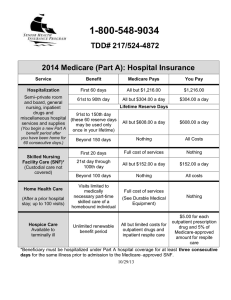Provider Based Billing - American College of Physicians
advertisement

American College of Physicians Policy on Provider-Based Billing Introduction Provider-based billing is the practice of charging for physician services separately from building/ facility overhead. This is an increasingly common way for hospitals to operate their outpatient facilities because it can cover for additional costs. In the provider-based billing model, also commonly referred to as hospital outpatient billing, patients may receive two charges on their combined patient bill for services provided within a clinic. One charge represents the facility or hospital charge and one charge represents the professional or physician fee. From 2008 to 2009, Medicare payments per fee-for-service (FFS) beneficiary for hospital inpatient and outpatient services grew by 6 percent.1 In FY2009 Medicare spent $34 billion on FFS outpatient care at acute care hospitals.1 Furthermore there is concern that significant payment disparities among Medicare’s ambulatory care settings for similar services are fostering undesirable financial incentives. Physician practices and ambulatory surgical centers may reorganize as hospital outpatient entities in part to receive higher reimbursements for the same or similar services. The Medicare Payment Advisory Commission (MedPAC) reports that about a quarter of the increase in volume in outpatient departments is due to a shift in the site of physician office visits from freestanding offices to physician offices that are owned by the hospital or deemed part of that outpatient department. When patients visit a physician office that is part of a hospital’s outpatient department, Medicare pays a facility fee to the hospital and a reduced fee for the physician’s services. The combined fees paid by Medicare for visits to hospital-based practices are often more than 50 percent greater than rates paid to freestanding practice.1 In 2009, the volume of visits to the higher paid outpatient-based practices owned by hospitals grew by 9 percent, while visits to free-standing practices grew by less than 1 percent.1 Patients also often end up paying more for certain outpatient services and procedures at provider based/hospital outpatient locations than at free-standing sites. This higher cost sharing can be due to increased out-of-pocket costs and premium increases.2 For example, patients with insurance will often have a typical co-payment of $25 for the doctor visit and a co-insurance payment that is approximately 20-30% of the facility fee.3 In addressing provider-based billing ACP recognizes the importance of balancing the needs of the community and the unintended consequences of abolishing provider-based billing. In many rural areas, hospitals and patients rely on the care provided in these settings. In addition, abolishing provider-based billing could have an effect on salaries of physicians employed by such entities, an effect on medical education programs at such entities, and an effect on availability of services provided to uninsured patients at such entities. The ACP believes that care should be provided in the most efficient setting possible, while maintaining quality of care, and supports policies consistent with the statements below. Policy Statements 1. The College does not support provider based billing for care delivered in an outpatient, hospital-system owned practice when that care is not dependent on the hospital facility and its associated technologies. Rather, in line with the College’s high value care initiative, the College supports delivery of care in the most efficient setting, while maintaining quality of care. While there are certainly instances where the additional technology and other services of a hospital facility are necessary to a physician office visit, many visits to internal medicine specialists, including most standard evaluation and management (E&M) office visits (e.g., CPT code 99213) do not require the availability of those additional services. However, according to MedPAC, there was a 6.7 percent increase in the number of these 99213 office visits furnished in outpatient departments from 2009 to 2010—likely resulting in an increase in Medicare expenditures and beneficiary cost sharing without any difference in patient care.2 And, if the percentage of all E&M office visits that are provided in hospital-owned practices continues at its 2010 growth rate of 12.9 percent over 10 years, then about 24.5 percent of E&M office visits will occur in hospital-owned practices in 2020.2 This shift would ultimately increase Medicare program spending by $2.0 billion per year and beneficiary cost sharing by $500 million per year—all without any discernable difference in patient care.2 Therefore, in line with the College’s high value care initiative, the College supports delivery of care in the most efficient setting, while maintaining quality of care.4 It is simply not appropriate for payers and patients to be subjected to increased costs for the same level and quality of care because the physical location and/or the business arrangement of the practice are different from a freestanding physician office. 2. Hospitals and hospital-owned outpatient practices should be transparent about their billing policies with patients prior to providing care, particularly if the patient and/or their health plan will be responsible for both physician service and hospital facility fees. The College strongly supports health care transparency. As defined by the Institute of Medicine (IOM), health care transparency involves making available to the public, in a reliable, and understandable manner, information on the health care system’s quality, efficiency, and consumer experience with care, which includes price and quality data, so as to influence the behavior of patients, providers, payers, and others to achieve better outcomes.5 CMS requires, as part of the criteria for determination of provider-based status, that a provider-based entity is held out to the public and other payers as part of the main hospital. When patients enter the providerbased facility, CMS states that the patient must be aware that they are entering a part of the main hospital and are billed accordingly. In addition, CMS requires hospital outpatient departments that are not located on the main provider’s campus to provide written notice to the beneficiary, before delivery of services, of the amount of the beneficiary’s potential financial liability (i.e. coinsurance for an outpatient visit to the hospital and the physician service).6 CMS has not 2 April 2013 specified how hospital-owned outpatient practices must ensure public awareness, however facilities often fulfill this requirement by ensuring that the entity’s signage, marketing materials, websites, stationary, etc. include the name of the main hospital and create the clear impression that the facility is part of that hospital. Although including the name of the main hospital associated with the facility increases the transparency of the provider based billing, the College supports further transparency. For example, providing written notice to the beneficiary regarding the billing policies and potential financial liability would further increase billing transparencies for patients. In the 2010 policy paper Healthcare Transparency – Focus on Price and Clinical Performance Information, ACP recommended price and performance transparency in the healthcare field. The College believes that transparent healthcare information is useful for a wide range of stakeholders and that it can help patients and their families make informed healthcare choices. In addition, transparency can also improve quality, safety, and efficiency throughout the health care system due to the competition and/or availability of clinical benchmarks.7 Transparency of provider-based billing policies, especially in hospital-owned outpatient practices, is important in ensuring transparency in the health care system and educating patients so they are able to make informed decisions about where to seek medical care. In addition, there have been instances over the past few years where patients have gone to visit their doctor, only to find out after that the practice has been purchased by a local hospital and that their bills are more than double what they were before.3 3. Provider based billing should not be used as a mechanism for hospitals to recoup/stabilize funding or as a means of ensuring access to care. Ensuring adequate hospital funding and patients’ access to care can better be addressed and supported through other means, such as increased/improved health insurance coverage, strengthened workforce policies, and delivery system reforms. The College recognizes the unique funding challenges hospitals face in the current economy and supports improving and updating the appropriate hospital funding streams. These additional costs are associated with a myriad of regulatory requirements, such as EMTALA, hospital licensure requirements, and Medicare conditions of participation.8 However, the College does not support utilizing provider based billing to help ease the financial burden of these additional costs. Care should be compensated for the most efficient and effective care available. Using provider-based billing to cover additional costs of the hospital puts an increased financial burden on patients through higher out-of-pocket costs and increased co-insurance payments. In addition, it requires insurance companies to pay more for the same or similar care. It is likely that insurance companies will then further shift these increased costs to the patient through higher premiums. The College does not believe that provider based billing is the most appropriate means of ensuring access to care. Patients’ access to care can better be addressed and supported through other means, such as increased/improved health insurance coverage, strengthened workforce policies, and delivery system reforms. The College recognizes the challenges faced by rural and safety-net facilities and supports the development and implementation of appropriate funding streams for these centers. In addition, the College is concerned that cutting payments to these facilities that are already struggling financially would further threaten the sustainability of these facilities and their ability to provide care in underserved areas. The federal government should develop and implement new and innovative approaches, building on payment and delivery 3 April 2013 system reform efforts, to support safety-net health care facilities that provide a disproportionate share of care for patients who are uninsured, covered by Medicaid, or indigent.9 These approaches will better serve to support safety net facilities over the longer term, thus removing their dependence on provider-based billing. There are alternative, more appropriate, mechanisms that hospitals could pursue to recoup costs and ensure patient access to care, such as moving towards new delivery payment models including Accountable Care Organizations (ACOs), bundled payments, and collaborations with patient centered medical homes (PCMHs). These models are intended to improve care coordination and quality while reducing the rate of spending growth.10 In addition, as our health care system moves toward reimbursement that rewards value rather than volume, CMS has established initiatives that encourage high-quality, coordinated care at lower costs, which could help hospitals’ recoup costs. For example, since the Affordable Care Act, CMS has rolled out many reforms that promote improved care, such as the Medicare Shared Savings Program, Hospital Value-Based Purchasing (VBP), and the strengthened Medicare Advantage 5-Star Rating program.11 These initiatives are intended to reduce spending and could be used by hospitals to stabilize funding streams. 1 Medicare Payment Policy – Report to the Congress March 2011. Medicare Payment Advisory Commission. Accessed online at http://medpac.gov/documents/Mar11_EntireReport.pdf 2 Medicare Payment Policy – Report to the Congress March 2012. Medicare Payment Advisory Commission. Accessed online at http://www.medpac.gov/documents/Mar12_EntireReport.pdf 3 Ostrom, Carol. Why you might pay twice for one visit to doctor. The Seattle Times. November 5, 2012. Accessed online at http://mobile.seattletimes.com/story/today/2019600338/track-.-.-./ 4 High Value Care. American College of Physicians. Accessed online at http://www.acponline.org/clinical_information/resources/high_value_care/ 5 Institute of Medicine. Crossing the Quality Chasm: A New Health System for the Twenty-First Century. National Academies Press.2001. 6 Requirements for determination that a facility or an organization has provider-based status. Federal Regulation 42 CFR Ch. IV (10-1-11 Edition). Accessed online at http://www.gpo.gov/fdsys/pkg/CFR-2011-title42-vol2/pdf/CFR2011-title42-vol2-sec413-65.pdf 7 American College of Physicians. Healthcare Transparency—Focus on Price and Clinical Performance Information. Philadelphia: American College of Physicians; 2010: Policy Paper. (Available from American College of Physicians, 190 N. Independence Mall West, Philadelphia, PA 19106.) Accessed online at http://www.acponline.org/advocacy/where_we_stand/policy/transparency.pdf 8 AHA letter to MedPAC Dec 13 2011. Accessed online at www.aha.org/advocacy.../letter/2011/111213-let-pollackmedpac.pdf 9 American College of Physicians. National Immigration Policy and Access to Health Care. Philadelphia: American College of Physicians; 2011: Policy Paper. (Available from American College of Physicians, 190 N. Independence Mall West, Philadelphia, PA 19106.) Accessed online at http://www.acponline.org/advocacy/where_we_stand/policy/natl_immigration.pdf 10 New payment and delivery reform models. American Medical Association. Accessed online at http://www.amaassn.org/ama1/pub/upload/mm/399/hsr-payment-reform-models.pdf 11 Statement by Jonathan Blum. Improving Quality, Lowering Costs – The Role of the Health Care Delivery System. Department of Health and Human Services. Accessed online at http://www.hhs.gov/asl/testify/2011/11/t20111110a.html 4 April 2013

